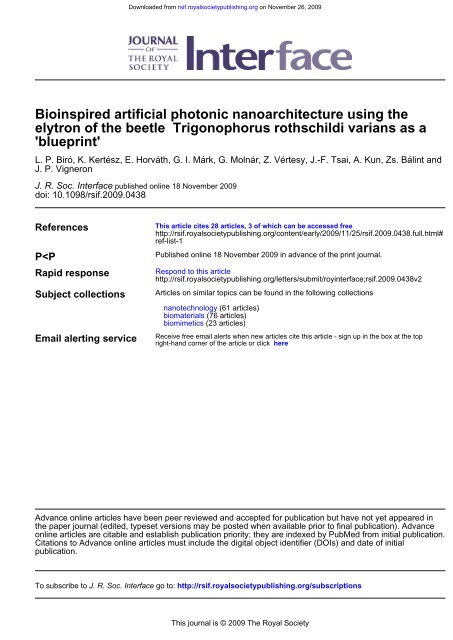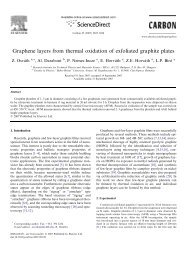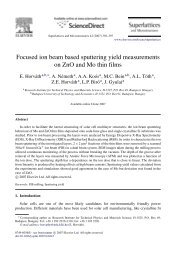as a Trigonophorus rothschildi varians elytron of the beetle ...
as a Trigonophorus rothschildi varians elytron of the beetle ...
as a Trigonophorus rothschildi varians elytron of the beetle ...
- No tags were found...
Create successful ePaper yourself
Turn your PDF publications into a flip-book with our unique Google optimized e-Paper software.
Downloaded from rsif.royalsocietypublishing.org on November 26, 20092 Artificial photonic nanoarchitecture L. P. Biró et al.dimensions (Joannopoulos et al. 2008). On <strong>the</strong> o<strong>the</strong>rhand, very few structures composed <strong>of</strong> intercalatedstructures <strong>of</strong> different dimensions have been investigated(Chutinan & John 2005). Intercalated photonicnanoarchitectures are understood <strong>as</strong> complex nanostructuresthat can be decomposed into two or moredistinct nanostructures, each with its characteristicdimensionality (one, two or three dimensions). Theindividual nanostructures composing <strong>the</strong> intercalatednanoarchitecture occupy <strong>the</strong> same volume, interpenetratingeach o<strong>the</strong>r. An example composed <strong>of</strong>intercalated one- and two-dimensional photonic nanostructures<strong>of</strong> biological origin h<strong>as</strong> been recentlyreported for <strong>the</strong> first time (R<strong>as</strong>sart et al. 2008). Sucha naturally occurring intercalated structure, found in<strong>the</strong> elytra <strong>of</strong> T. <strong>rothschildi</strong> <strong>varians</strong>, w<strong>as</strong> characterizedstructurally and optically and reproduced artificially.2. EXPERIMENTAL RESULTSAND DISCUSSIONThe first remarkable feature <strong>of</strong> <strong>the</strong> T. <strong>rothschildi</strong><strong>varians</strong> <strong>beetle</strong>s is that, in <strong>the</strong> same habitat and in <strong>the</strong>same period, one may encounter various colours rangingfrom orange to violet or even black (figure 1). Fieldobservation yields an 80 per cent occurrence <strong>of</strong> <strong>the</strong>green variant, 10 per cent for <strong>the</strong> orange variant andaround 5 per cent for <strong>the</strong> violet variant, while <strong>the</strong> restare black or <strong>of</strong> mixed colour (e.g. Harink 2009). Sucha colour variation within <strong>the</strong> same population <strong>of</strong> <strong>beetle</strong>sw<strong>as</strong> investigated previously in only one c<strong>as</strong>e and attributedto a simple one-dimensional PhC-type structure(Kurachi et al. 2002).The second remarkable feature <strong>of</strong> <strong>the</strong> colour <strong>of</strong> <strong>the</strong>se<strong>beetle</strong>s is its visibility under a wide angular range, abehaviour not expected from a simple multilayer structure.Scanning electron microscopy (SEM) reveals amultilayer structure (one-dimensional PhC); <strong>the</strong> resultsfor an orange, a green and a violet individual are shownin figure 2a. One may note in <strong>the</strong> SEM images that, in <strong>as</strong>omewhat unusual way, <strong>the</strong> parallel layers <strong>of</strong> <strong>the</strong> multilayerstructure are crossed by rod-like formations. Thepresence <strong>of</strong> <strong>the</strong> multilayer and rod-like formations in<strong>the</strong> same volume indicates an intercalated photonicnanoarchitecture. The insets in figure 2a give <strong>the</strong>period <strong>of</strong> <strong>the</strong> one-dimensional PhC, <strong>as</strong> me<strong>as</strong>ured from<strong>the</strong> SEM images (orange, 200 nm; green, 180 nm; andviolet, 150 nm), and <strong>the</strong> calculated position <strong>of</strong> <strong>the</strong>reflectance maxima for normal incidence (orange,590 nm; green, 531 nm; and violet, 443 nm) using <strong>as</strong>imple multilayer approach. The same value <strong>of</strong> 0.15pfor <strong>the</strong> air gap between <strong>the</strong> chitin layers (n ¼ 1.56;Vukusic et al. 1999) w<strong>as</strong> used for all three colours(where p is <strong>the</strong> average period <strong>of</strong> <strong>the</strong> multilayer, <strong>as</strong>me<strong>as</strong>ured from SEM images). The absence <strong>of</strong> fillingbetween <strong>the</strong> chitin layers w<strong>as</strong> checked by cutting <strong>the</strong>elytra at an oblique angle and carefully examining <strong>the</strong>cut with SEM. Similar air gaps were found previouslyin metallic wood-boring <strong>beetle</strong>s, too (Vigneron et al.2006).Somewhat unexpectedly, when me<strong>as</strong>uring <strong>the</strong>normal incidence reflectance on <strong>the</strong> flattest region <strong>of</strong>Figure 1. Group <strong>of</strong> T. <strong>rothschildi</strong> <strong>varians</strong> in <strong>the</strong>ir natural habitat.The three colour variations discussed in <strong>the</strong> paper can beclearly distinguished. One may note that some green andorange individuals seen under certain angles may exhibit anapparently dark brown coloration, which disappears with<strong>the</strong> change <strong>of</strong> <strong>the</strong> observation angle.<strong>the</strong> elytra with a fibre-optic spectrometer (Av<strong>as</strong>pec2048/2), using a white diffuse reflectance standard forcomparison, no clear maxima were found. An almostflat plateau w<strong>as</strong> found for all investigated colours in<strong>the</strong> wavelength range <strong>of</strong> 300–650 nm, with reflectancevalues in <strong>the</strong> range <strong>of</strong> 50 per cent. This unsaturatedreflectance is attributed to <strong>the</strong> topmost, unstructuredgl<strong>as</strong>sy (wax) layer <strong>of</strong> <strong>the</strong> epicuticle, seen in figure 2afor <strong>the</strong> violet T. <strong>rothschildi</strong>. In contr<strong>as</strong>t, when me<strong>as</strong>uring<strong>the</strong> reflectance with an integrating sphere(illuminating <strong>the</strong> sample at an 88 deviation fromnormal and collecting <strong>the</strong> reflected light under allangles), well-defined reflectance maxima were found atwavelengths in satisfactory agreement with <strong>the</strong> calculatedvalues in <strong>the</strong> inset <strong>of</strong> figure 2a. The reflectancecurves me<strong>as</strong>ured with <strong>the</strong> integrating sphere and <strong>the</strong>photographs taken under identical conditions on <strong>the</strong>elytra under normal incidence are shown infigure 2b,c, respectively. One may note that, underclose to normal observation (in both figures 1 and 2c)in <strong>the</strong> topmost part <strong>of</strong> <strong>the</strong> elytra, <strong>the</strong> colour is brownish,ra<strong>the</strong>r than having a saturated, vivid colour. Suchbehaviour is unexpected for a one-dimensional PhC(multilayer) and indicates <strong>the</strong> presence <strong>of</strong> non-specularcomponents in <strong>the</strong> reflectance.To elucidate <strong>the</strong> possible role <strong>of</strong> pigmentation, 1 mmthick cross-sections <strong>of</strong> <strong>the</strong> elytra were prepared for opticalmicroscopy. As shown in figure 2d, only <strong>the</strong> region <strong>of</strong><strong>the</strong> epicuticle containing <strong>the</strong> one-dimensional PhC w<strong>as</strong>pigmented, and all three investigated <strong>beetle</strong>s showed<strong>the</strong> same yellow-brownish pigmentation, very likelyarising from melanin.To gain more insight into <strong>the</strong> way in which incidentlight is reflected by <strong>the</strong> <strong>elytron</strong> <strong>of</strong> T. <strong>rothschildi</strong> <strong>varians</strong>,we carried out careful spectro-goniometric me<strong>as</strong>urementsusing <strong>the</strong> Av<strong>as</strong>pec fibre-optic spectrometer incombination with a goniometric stage in a similarset-up to that reported earlier (Kertész et al. 2006). In<strong>the</strong> first experiment, <strong>the</strong> flattened piece <strong>of</strong> <strong>the</strong> <strong>elytron</strong>w<strong>as</strong> initially illuminated under close to normal incidence,in such a way that <strong>the</strong> illumination fibre andJ. R. Soc. Interface
Downloaded from rsif.royalsocietypublishing.org on November 26, 20096 Artificial photonic nanoarchitecture L. P. Biró et al.75°50°45°35°(a)Figure 5. Artificial nanoarchitectures created using <strong>the</strong> <strong>elytron</strong>structure <strong>as</strong> a ‘blueprint’. All squares except <strong>the</strong> rightmostcolumn are squares with a random distribution <strong>of</strong> holes; <strong>the</strong>rightmost column is a square pattern <strong>of</strong> holes. (a) SEM image<strong>of</strong> <strong>the</strong> random hole distribution nanomachined in <strong>the</strong> 5 (SiO/SiGe) multilayer. (b) SEM image <strong>of</strong> <strong>the</strong> square hole patternnanomachined in <strong>the</strong> 5 (SiO/SiGe) multilayer (samescale bar valid for both (a,b), 1 mm). (c)–(g) Photographstaken through an optical microscope showing <strong>the</strong> samenanoarchitectures under different illumination conditions(except in (g), <strong>the</strong> plane <strong>of</strong> <strong>the</strong> incoming light is not parallelwith <strong>the</strong> rows <strong>of</strong> <strong>the</strong> square pattern). The rightmost square is<strong>the</strong> regular hole pattern (centre-to-centre distance <strong>of</strong> holes:746 nm); all o<strong>the</strong>rs are random hole distributions (from left toright, <strong>the</strong> average hole distance is 743, 743, 609 and 580 nm).The angle <strong>of</strong> illumination with respect to <strong>the</strong> normal <strong>of</strong> <strong>the</strong>multilayer structure is indicated. Like in <strong>the</strong> c<strong>as</strong>e <strong>of</strong> <strong>the</strong> naturalstructure, by changing <strong>the</strong> angle between <strong>the</strong> observation andillumination directions, <strong>the</strong> colour is shifted only moderatelyfor <strong>the</strong> squares with random hole distribution. Note that <strong>the</strong>one-dimensional PhC under <strong>the</strong> very same conditions doesnot reflect light (black background) and <strong>the</strong> colour changeexhibited by <strong>the</strong> regular square array <strong>of</strong> holes (rightmostcolumn <strong>of</strong> squares) is significantly larger than for <strong>the</strong> randomarrays <strong>of</strong> holes. (g) Illumination angle with respect to <strong>the</strong>plane <strong>of</strong> <strong>the</strong> squares <strong>as</strong> in (e), but <strong>the</strong> plane <strong>of</strong> illumination isrotated at an angle <strong>of</strong> 458 with respect to <strong>the</strong> rows <strong>of</strong> holes <strong>of</strong><strong>the</strong> regular (square) pattern. Note that <strong>the</strong> regular pattern disappears,while all <strong>of</strong> <strong>the</strong> random patterns exhibit colour. (h)Thesquare patterns seen under <strong>the</strong> microscope when illuminatedthrough <strong>the</strong> microscope objective. Note that all squaresappear similarly darker than <strong>the</strong> bright yellow (unmodifiedone-dimensional PhC) background. Scale bar: (c) 50mm.(b)(c)(d)(e)( f )(g)(h)w<strong>as</strong> used (figure 5h), <strong>the</strong>n external illumination w<strong>as</strong>used under several angles (figure 5c–g). Under illuminationthrough <strong>the</strong> microscope, <strong>the</strong> squares appeardarker than <strong>the</strong> unmodified multilayer due to <strong>the</strong>light scattered under different angles (because <strong>of</strong> <strong>the</strong>wider angular spread, less light will be collected by<strong>the</strong> microscope objective) <strong>as</strong> compared with <strong>the</strong>one-dimensional structure. All squares appear brownish-yellow,while <strong>the</strong> unmodified multilayer is brightyellow (figure 5h).Subsequently, an external light source w<strong>as</strong> used tomake it possible to change <strong>the</strong> angle <strong>of</strong> illuminationwhile keeping <strong>the</strong> position <strong>of</strong> <strong>the</strong> objective and <strong>the</strong>sample unchanged. In figure 5c–f, <strong>the</strong> light w<strong>as</strong> incidentin a plane parallel with <strong>the</strong> rows <strong>of</strong> holes in <strong>the</strong>regular pattern, while <strong>the</strong> angle <strong>of</strong> <strong>the</strong> illumination, <strong>as</strong>me<strong>as</strong>ured from <strong>the</strong> sample normal, w<strong>as</strong> changed from758 to 358. Infigure 5g, <strong>the</strong> illumination angle withrespect to <strong>the</strong> sample normal w<strong>as</strong> fixed at 458, <strong>as</strong>infigure 5e, but <strong>the</strong> sample w<strong>as</strong> rotated in its plane sothat <strong>the</strong> plane <strong>of</strong> incidence <strong>of</strong> <strong>the</strong> light made an angle<strong>of</strong> 458 with <strong>the</strong> rows <strong>of</strong> <strong>the</strong> regular pattern.The one-dimensional PhC appears <strong>as</strong> a black backgrounddue to its specular behaviour, while all <strong>the</strong>squares show different colours that depend on <strong>the</strong> illuminationangle, <strong>the</strong> period and regular or irregulararrangement <strong>of</strong> <strong>the</strong> holes (figure 5c–g). One can e<strong>as</strong>ilysee that <strong>the</strong> most significant difference in colour is producedby <strong>the</strong> regular versus irregular arrangement <strong>of</strong><strong>the</strong> holes, <strong>the</strong> change <strong>of</strong> <strong>the</strong> illumination angle being aless important factor. It is worth pointing out that <strong>the</strong>colour <strong>of</strong> <strong>the</strong> regular pattern is significantly more illuminationangle dependent than that <strong>of</strong> <strong>the</strong> randompatterns, irrespective <strong>of</strong> <strong>the</strong>ir average hole-to-holedistance (figure 5). Ano<strong>the</strong>r very significant differencebetween <strong>the</strong> regular and <strong>the</strong> random patterns is <strong>the</strong> disappearance<strong>of</strong> <strong>the</strong> regular pattern when <strong>the</strong> orientation<strong>of</strong> <strong>the</strong> illumination plane makes an angle <strong>of</strong> 458 with<strong>the</strong> rows <strong>of</strong> holes (figure 5g). This is a strong indicationthat <strong>the</strong> colour <strong>of</strong> <strong>the</strong> regular pattern is producedmainly by diffraction. In contr<strong>as</strong>t, <strong>the</strong> random patternscontinue to be seen <strong>as</strong> coloured under <strong>the</strong>se conditions,too. The change in <strong>the</strong> colour <strong>of</strong> <strong>the</strong> random patternsfrom left to right <strong>as</strong> <strong>the</strong> average hole-to-hole distance isreduced by 20 per cent (in <strong>the</strong> fourth pattern from <strong>the</strong>left) is small. The above differences show that <strong>the</strong> behaviour<strong>of</strong> <strong>the</strong> intercalated nanoarchitectures with <strong>the</strong>random two-dimensional holes differs both from <strong>the</strong>one-dimensional multilayer and from <strong>the</strong> onedimensionalmultilayer intercalated with a regularsquare array <strong>of</strong> holes. The moderate change <strong>of</strong> colourwith <strong>the</strong> change <strong>of</strong> <strong>the</strong> illumination angle is similarto <strong>the</strong> behaviour <strong>of</strong> <strong>the</strong> biological ‘blueprint’.The way in which <strong>the</strong> colour <strong>of</strong> <strong>the</strong> intercalatedstructures depends on <strong>the</strong> incre<strong>as</strong>e in <strong>the</strong> angle between<strong>the</strong> illumination and observation angles is different for<strong>the</strong> natural and <strong>the</strong> artificial nanoarchitectures. Thisis attributed to <strong>the</strong> more complex structure <strong>of</strong> <strong>the</strong> naturalnanoarchitectures, in which <strong>the</strong> cylindrical elementsconstituting <strong>the</strong> random two-dimensional PBGmaterial penetrating through <strong>the</strong> one-dimensionalstructure are not simple holes, but ra<strong>the</strong>r are cylinderswith a finite wall thickness.J. R. Soc. Interface
Downloaded from rsif.royalsocietypublishing.org on November 26, 2009Artificial photonic nanoarchitecture L. P. Biró et al. 73. CONCLUSIONSIn summary, we revealed an unusual, intercalated photonic-crystal-typenanoarchitecture in <strong>the</strong> <strong>elytron</strong> <strong>of</strong> <strong>the</strong>Taiwanese <strong>beetle</strong>, T. <strong>rothschildi</strong> <strong>varians</strong>, whichcanberegarded <strong>as</strong> being composed <strong>of</strong> a two-dimensional,random PBG material (or amorphous PBG material)(Edagawa et al. 2008) intercalated between <strong>the</strong> layers<strong>of</strong> a regular, one-dimensional PhC. This intercalatedPhC clearly shows different reflecting properties <strong>as</strong> comparedwith a Bragg reflector. A similar but not identicalbioinspired nanoarchitecture w<strong>as</strong> produced by FIB etchingholes through a regular multilayer structure (Braggreflector). Both <strong>the</strong> biological ‘blueprint’ and its artificialcounterpart show similar behaviour, like non-specularityand only slightly angle-dependent reflectance. Differencesattributed to <strong>the</strong> more complex structure <strong>of</strong> <strong>the</strong>natural nanoarchitecture influence <strong>the</strong> specific angledependence <strong>of</strong> <strong>the</strong> observed colour. As <strong>the</strong> manufacturing<strong>of</strong> three-dimensional, intercalated PhCs like <strong>the</strong>ones investigated in <strong>the</strong> present paper is a lotsimpler—with well-established technologies like thinfilm growth, lithography and etching, or ion-beamb<strong>as</strong>edmethods like FIB—than o<strong>the</strong>r methods <strong>of</strong>producing three-dimensional photonic nanoarchitectures,bioinspiration may provide valuable blueprints inadvancing <strong>the</strong> production <strong>of</strong> new types <strong>of</strong> intercalatedphotonic nanoarchitectures.The present work w<strong>as</strong> supported by an OTKA-NKTH grant67793 in Hungary, by a joint agreement between <strong>the</strong>Hungarian Academy <strong>of</strong> Science and NSC in Taiwan formobility and by a mobility programme between <strong>the</strong> HAS inHungary and FNRS in Belgium.REFERENCESBerthier, S. 2007 Iridescences: <strong>the</strong> physical colors <strong>of</strong> insects.New York, NY: Springer.Biró, L. P., Kertész, K., Vértesy, Z., Márk, G. I., Bálint, Zs.,Lousse, V. & Vigneron, P. 2007 Living photonic crystals:butterfly scales—nanostructure and optical properties.Mat. Sci. Eng. C 27, 941–946. (doi:10.1016/j.msec.2006.09.043)Chutinan, A. & John, S. 2005 Diffractionless flow <strong>of</strong> lightin two- and three-dimensional photonic band gap heterostructures:<strong>the</strong>ory, design rules, and simulations.Phys. Rev. E 71, 026605-1–026605-19. (doi:10.1103/Phys-RevE.71.026605)Edagawa, K., Kanoko, S. & Notomi, M. 2008 Photonic amorphousdiamond structure with a 3D photonic band gap.Phys. Rev. Lett. 100, 013901-1–013901-4. (doi:10.1103/PhysRevLett.100.013901)Giraldo, M. A., Yoshioka, S. & Stavenga, D. G. 2008 Far fieldscattering pattern <strong>of</strong> differently structured butterflyscales. J. Comp. Physiol. A 194, 201–207. (doi:10.1007/s00359-007-0297-8)Gondarenko, A., Preble, S., Robinson, J., Chen, L., Lipson, H. &Lipson, M. L. 2006 Spontaneous emergence <strong>of</strong> periodic patternsin a biologically inspired simulation <strong>of</strong> photonicstructures. Phys. Rev. Lett. 96, 143904-1–143904-4.(doi:10.1103/PhysRevLett.96.143904)Harink, B. 2009 See http://www.harink.com/~benjamin/28.07.2007/<strong>Trigonophorus</strong>%20<strong>rothschildi</strong>%20<strong>rothschildi</strong>%20-set.JPG.Huang, J., Wang, X. & Wang, Z. L. 2006 Controlled replication<strong>of</strong> butterfly wings for achieving tunable photonicproperties. Nano Lett. 6, 2325–2331. (doi:10.1021/nl061851t)Joannopoulos, J. D., Johnson, S. G., Winn, J. N. & Meade,R. D. 2008 Photonic crystals: molding <strong>the</strong> flow <strong>of</strong>light, 2nd edn. Princeton, NJ: Princeton UniversityPress. See http://ab-initio.mit.edu/book/photonic-crystals-book.pdf.John, S. 1987 Strong localization <strong>of</strong> photons in certaindisordered dielectric superlattices. Phys. Rev. Lett. 58,2486–2489. (doi:10.1103/PhysRevLett.58.2486)Kertész, K., Bálint, Zs., Vértesy, Z., Márk, G. I., Lousse, V.,Vigneron, J. P., R<strong>as</strong>sart, M. & Biró, L. P. 2006 Gleamingand dull surface textures from photonic-crystal-type nanostructuresin <strong>the</strong> butterfly Cyanophrys remus. Phys. Rev. E74, 021922-1–021922-15. (doi:10.1103/PhysRevE.74.021922)Kertész, K. et al. 2008 Photonic band gap materials in butterflyscales: a possible source <strong>of</strong> ‘blueprints’. Mat. Sci. Eng. B149, 259–265. (doi:10.1016/j.mseb.2007.10.013)Kurachi, M., Takaku, Y., Komiya, Y. & Hariyama, T. 2002The origin <strong>of</strong> extensive colour polymorphism inPlateumaris sericea (Chrysomelidae, Coleoptera).Naturwissenschaften 89, 295–298. (doi:10.1007/s00114-002-0332-0)Parker, A. 2004 In <strong>the</strong> blink <strong>of</strong> an eye: how vision kick-started<strong>the</strong> big bang <strong>of</strong> evolution. London, UK: Simon & SchusterUK Ltd.Parker, A. R. & Townley, H. E. 2007 Biomimetics <strong>of</strong> photonicnanostructures. Nat. Nanotechnol. 2, 347–353. (doi:10.1038/nnano.2007.152)Parker, A. R., McKenzie, D. R. & Large, M. C. J. 1998 Multilayerreflectors in animals using green and gold <strong>beetle</strong>s <strong>as</strong>contr<strong>as</strong>ting examples. J. Exp. Biol. 201, 1307–1313.Parker, A. R., Welch, V. L., Driver, D. & Martini, N. 2003Opal analogue discovered in a weevil. Nature 426,786–787. (doi:10.1038/426786a)Potyrailo, R. A., Ghiradella, H., Vertiatchikh, A., Dovidenko,K., Cournoyer, J. R. & Olson, E. 2007 Morpho butterflywing scales demonstrate highly selective vapourresponse. Nat. Photon. 1, 123–128. (doi:10.1038/nphoton.2007.2)Prum, R. O., Quinn, T. & Torres, R. H. 2006 Anatomicallydiverse butterfly scales all produce structural colours bycoherent scattering. Exp. Biol. 209, 748–765. (doi:10.1242/jeb.02051)R<strong>as</strong>sart, M., Colomer, J.-F., Tabarrant, T. & Vigneron, J. P.2008 Diffractive hygrochromic effect in <strong>the</strong> cuticle <strong>of</strong> <strong>the</strong>hercules <strong>beetle</strong> Dyn<strong>as</strong>tes Hercules. New J. Phys. 10,033014-1–033014-14. (doi:10.1088/1367-2630/10/3/033014)Sanchez, C., Arribart, H. & Giraud Guille, M. M. 2005 Biomimetismand bioinspiration <strong>as</strong> tools for <strong>the</strong> design <strong>of</strong>innovative materials and systems. Nat. Mat. 4, 277–288.(doi:10.1038/nmat1339)Sarikaya, M., Tamerler, C., Jen, A. K.-Y., Schulten, K. &Baneyx, F. 2003 Molecular biomimetics: nanotechnologythrough biology. Nat. Mat. 2, 577–585. (doi:10.1038/nmat964)Seago, A. E., Brady, P., Vigneron, J.-P. & Schultz, T. D. 2009Gold bugs and beyond: a review <strong>of</strong> iridescence and structuralcolour mechanisms in <strong>beetle</strong>s (Coleoptera).J. R. Soc. Interface 6, S165–S184. (doi:10.1098/rsif.2008.0354.focus)Taflove, A. & Hagness, S. 2005 Computational electrodynamics:<strong>the</strong> finite-difference time-domain method,3rd edn. Norwood, MA: Artech House Publishers.J. R. Soc. Interface
Downloaded from rsif.royalsocietypublishing.org on November 26, 20098 Artificial photonic nanoarchitecture L. P. Biró et al.Vigneron, J. P., R<strong>as</strong>sart, M., Vandenbem, C., Lousse, V.,Deparis, O., Biró, L. P., Dedouaire, D., Cornet, A. &Defrance, P. 2006 Spectral filtering <strong>of</strong> visible light by <strong>the</strong>cuticle <strong>of</strong> metallic woodboring <strong>beetle</strong>s and micr<strong>of</strong>abrication<strong>of</strong> a matching bioinspired material. Phys. Rev. E 73,041905-1–041905-8. (doi:10.1103/PhysRevE.73.041905)Vigneron, J. P. et al. 2007 Switchable reflector in <strong>the</strong> Panamaniantortoise <strong>beetle</strong> Charidotella egregia (Chrysomelidae:C<strong>as</strong>sidinae). Phys. Rev. E 76, 031907-1–031907-9.(doi:10.1103/PhysRevE.76.031907)Vukusic, P. & Sambles, J. R. 2003 Photonic structures inbiology. Nature 424, 852–855. (doi:10.1038/nature01941)Vukusic, P., Sambles, J. R., Lawrence, C. R. & Wootton, R. J.1999 Quantified interference and diffraction in singleMorpho butterfly scales. Proc. R. Soc. Lond. B 266,1403–1411. (doi:10.1098/rspb.1999.0794)Watanabe, K., Hoshimo, T., Kanda, K., Haruyama, Y., Kaito,T. & Matsui, S. 2005 Optical me<strong>as</strong>urement and fabricationfrom a Morpho-butterfly-scale qu<strong>as</strong>istructure by focusedion beam chemical vapor deposition. J. Vac. Sci. Technol.B 23, 570–574. (doi:10.1116/1.1868697)Welch, V., Lousse, V., Deparis, O., Parker, A. & Vigneron,J. P. 2007 Orange reflection from a three-dimensionalphotonic crystal in <strong>the</strong> scales <strong>of</strong> <strong>the</strong> weevil Pachyrrhynchuscongestus pavonius (Curculionidae). Phys. Rev. E 75,041919-1–041919-9. (doi:10.1103/PhysRevE.75.041919)Wickson, F. 2008 Narratives <strong>of</strong> nature and nanotechnology. Nat.Nanotechnol. 3, 313–315. (doi:10.1038/nnano.2008.140)Yablonovitch, E. 1987 Inhibited spontaneous emission insolid-state physics and electronics. Phys. Rev. Lett. 58,2059–2062. (doi:10.1103/PhysRevLett.58.2059)Yee, K. S. 1966 Numerical solution <strong>of</strong> initial boundary valueproblems involving Maxwell’s equations in isotropicmedia. IEEE Trans. Antenn. Propag. 14, 302–307.(doi:10.1109/TAP.1966.1138693)Yoshioka, S. & Kinoshita, S. 2007 Polarization-sensitive colormixing in <strong>the</strong> wing <strong>of</strong> <strong>the</strong> Madag<strong>as</strong>can sunset moth. Opt.Express 15, 2691–2701. (doi:10.1364/OE.15.002691)J. R. Soc. Interface





